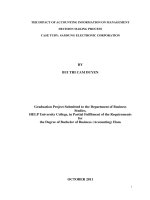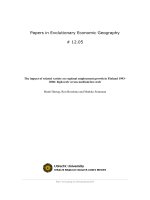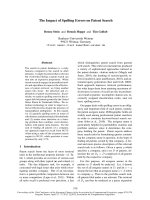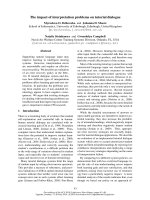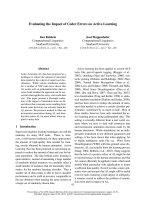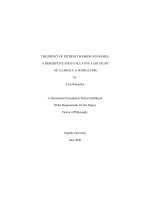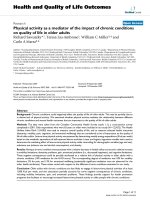The impact of domestic remittances on left-behind older people in Vietnam
Bạn đang xem bản rút gọn của tài liệu. Xem và tải ngay bản đầy đủ của tài liệu tại đây (270.99 KB, 11 trang )
Journal of Economics and Development, Vol.18, No.3, December 2016, pp. 30-40
ISSN 1859 0020
The Impact of Domestic Remittances on
Left-Behind Older People in Vietnam
Nguyen Van Cong
National Economics University, Vietnam
Email:
Tran Thi Truc
Academy of Policy and Development, Ministry of Planning and Investment, Vietnam
Email:
Abstract
In the context of an insufficient social protection system the economic lives of older people,
especially those living in rural areas, are greatly changed with socio-economic risks that are
associated with the strong rural-urban mobility of younger generations. This paper aims to
investigate the impacts on the economic well-being of old-age parents of domestic remittances,
sent by their children who have migrated from rural to urban areas. Using data from the Vietnam
Household Living Standard Survey (VHLSS) in 2004, 2008 and 2012 with logistic regression
models, we found that domestic remittances played an essential role in improving income/
expenditure per capita and reducing poverty rates of older people’s households. Domestic
remittances also contributed to reduce Gini coefficients, which were calculated using both income
and expenditure per capita.
Keywords: Aging; migration; domestic remittances; older people; Vietnam.
Journal of Economics and Development
30
Vol. 18, No.3, December 2016
1. Introduction
old-aged parents. Stark and Lucas (1988)
proved that domestic remittances from the migrants helped rural elderly households in Botswana to cope with the farming risks caused
by natural calamities. Cameron and CobbClark (2005), examining the case of Indonesia,
showed that mobile workers contribute partly
to their family members through remittances
and such remittances helped to improve the income and health of their old-age parents, particularly helping to reduce the farming time of
female older people in rural Indonesia. However, the authors emphasized that, as domestic
remittances could not provide sufficient full income for older people, they did not stop their
farming activities. For the case of Cambodian older people, Chandore (2010) also found
that remittances from migrating children were
economically significant for their left-behind
parents, who were in shortage of farming land
and thus income from cultivation. A number of
other studies also provided the same findings
(see, for instance, Burholt et al., 2003; Evandrou et al., 2009; and HelpAge International
and UNICEF, 2010).
Due to rapid declining fertility rates and improved life expectancies, Vietnam is moving
towards the end of the ‘demographic transition’
with a higher proportion of the population being older (aged 60 and over). Vietnam has been
considered one of the most aging populations
in the world, given its low-middle income status (UNFPA and HAI, 2012). It will only take
Vietnam less than 20 years to move from an
‘aging’ to an ‘aged’ population, while it took
Western and developed countries from 50 to
more than 100 years (UNFPA, 2011).
In addition, along with economic growth and
development since ‘Doi moi’, industrialization
and urbanization have made various changes
in the socio-economic lives of older people,
especially those living in rural areas, because
their living arrangements have changed rapidly
from traditional multi-generational to nuclear
families. The question is: how does the migration of children in households impact on older
people’s economic lives, in terms of domestic
remittances?
This paper aims to evaluate the impacts of
domestic remittances on older people’s economic lives using various well-being indicators, such as poverty rate and Gini coefficients.
It is structured as follows. In Section 2, we will
provide an overview of the literature. Data and
methodology will be described in Section 3.
Key findings and implications are analyzed in
Section 4, while Section 5 will provide some
concluding remarks.
In contrast, there have been other studies
showing that migrating children – as key laborers in the families – left significant negative effects on their old-aged parents in rural
areas. For instance, Gibson et al. (2009) indicated that the income of families with migrated laborers in Tonga decreased greatly in the
short term due to the fact that they did not have
any surplus money and remittances were used
to pay for loans to fund themigration costs of
the child(ren). In the case of Mexico, Antman
(2011) found that there was no difference in the
total finance contribution to the parents from
2. Literature review
There have been a number of studies showing the great impacts of domestic remittances
sent by their migrated children on left-behind
Journal of Economics and Development
31
Vol. 18, No.3, December 2016
the study indicated that remittances in general played an important role in reducing poverty and improving income equality for elderly
families. Le Bach Duong and Nguyen Thanh
Liem (2011) made a survey of the impact of
rural-urban migration on the home and host
communities and also discovered that the remittance from migrated children played an important role in mitigating the poverty and improving the living standard of the poor elderly
left behind in the rural areas.
all children between the time before and after
the migration of one or more children. More
importantly, the study added that the assistance time given to the parents reduced after
the child(ren) migrated. Sochanny Hak et al.
(2011), exploring the case of Cambodia, also
found that internal migration children did not
support their left-behind parents very much in
rural areas in terms of finance.
Given an increasing number of studies on
the impacts of domestic remittances on the
well-being of households in Vietnam, there
have been few researches discussing such impacts on older people. Barbieri (2006), for example, using data from the 1999 Population and
Housing Census and Vietnam Living Standard
Survey (VLSS) 1998, showed that more than
20 percent of older people left behind received
remittances from their migrated children, and
older women tended to receive more than did
older men. The author further insisted that the
migrated children were expected to contribute
significantly to their parents in terms of finance,
but their parents actually still worked for further
income. Giang and Pfau (2010) used logistic
models with VLSS 1993 and 1998 and VHLSS
2002 and 2004 and found that female-headed
elderly households got higher remittances than
did their male-headed counterparts. However,
3. Data and methodology
3.1. Data
In this study, we will use data from VHLSS
2004, 2008, and 2012. With a 4-year interval,
we hope to provide the trends of domestic remittances sent to older people over time. These
surveys were conducted by the General Statistics Office of Vietnam (GSO). They were organized at a household level but still provide
various individual information about household members such as age, sex, relationship to
the households’ head, marital status, working
status, and the highest education qualification.
As such, we could identify older people (those
aged 60 and over) and households with at least
one older person. The data were representative
at both national and area (urban and rural) levels.
Table 1: Samples for analysis from VHLSS
Year
Number of
households
Number of
individuals
Number of households with at
least one elderly person
Number of the
elderly
2004
9.189
39.696
2.785
3.806
2008
9.189
38.253
2.974
3.972
2012
9.399
36.655
2.922
3.978
Source: Own calculations, using VHLSS 2004, 2008 and 2012
Journal of Economics and Development
32
Vol. 18, No.3, December 2016
Table 1 presents information about samples
in the studied VHLSS.
mittances contributed to reducing expenditure
and income inequality.
In regard to migration and remittances, there
were questions related to the amount of domestic and international remittances which a
household received over a year. A remittance is
defined as the amount of money and/or the monetary value of in-kind transfers received by the
households from family members or relatives
who were not living in the households without
any requirement for being repaid. Therefore,
we could identify households receiving either
only domestic or international remittances or
both. In this paper, we used only households
receiving domestic remittances for our analysis. The main limitation in these three surveys
is that we could not know who received remittances or how they were spent.
To show how internal remittances had impact on poverty situation of the households
with at least one older person, we will apply
a logistic regression model as follows. Please
note that, in all calculations, individual and
household weights are used to show the results
which are as representative as possible for the
entire Vietnamese population as well as Vietnamese older people.
An older person i (i =1,2,…..,N, in which N
is the total number of the older population) is
considered to live in a poor household and is
considered to be poor (pi = 1) if his/her household’s average per-capita expenditure is below
the poverty line. The probability of being poor
can be estimated with a logistic model as follows:
3.2. Methodology
P(pi= 1) = βiXi + εi, (1)
Following the research objectives, we will
first explore the time trends of remittance flows
(with a focus on internal remittances) to the
households with at least one older person in
three surveys.
In which:
Xi represents a variety of individual and
household characteristics of the older persons,
in which receiving internal remittances is one
character;
To discuss how these remittance flows had
impacts on expenditure (in)equality, we will
estimate Gini coefficients for both income and
expenditure in two cases: (i) without internal
remittances; and (ii) with internal remittances. For the former, we will simply deduct the
total amount of internal remittances received
by each household from its total expenditure
or total income, and then calculate respective
Gini coefficients using this estimated total expenditure or total income. For the latter, we will
use the data as they were in the surveys. If Gini
coefficients of the former are greater than that
of the latter, we will conclude that internal reJournal of Economics and Development
βi is respective coefficient for each Xi; and
εi is the error term, and it is assumed to follow normal distribution.
From the model, we can calculate the odds
P
ratio (i.e., 1 − iP ). For each variable, we have a
i
group as the reference group, and thus the odds
ratio being greater than 1 means that the studied group was more likely to be poor than was
the reference group, and vice versa.
In the logistic model, we will have the following explanatory variables:
Age: This variable could impact on the in33
Vol. 18, No.3, December 2016
not completed lower secondary school level or
who have finished education at this level only
and (ii) the second sub-group is the elderly who
have completed high school education level or
more. The first group is selected as the reference group. In the logistics model used to determine the aspects impacting on elderly poverty, the estimated odds ratio is expected to be
less than 1 for the second group. This can be
explained in that the elderly with a high-school
educational level are likely to have had a higher-paid job previously, therefore they tend to
be paid a higher retirement pension upon their
retirement. This view was also illustrated by
Giang and Pfau (2010).
dividual receiving the internal remittance, because the older the individual, the more likely
the individual receives the internal remittance
or is not in poverty (Giang and Pfau, 2010).
This proves that the elderly tend to be dependent as they grow older. In the logistics model,
age is measured as a continuous variable.
Gender: this variable is used to identify the
potential gap in the probability of receiving remittance between elderly males and females.
Females are chosen to be the reference group.
The estimated odd ratio for females is expected
to be larger than 1 because the female elderly are considered to be less positive than their
counterparts and as a result they are more likely to receive are mittance from their migrating
children. This idea was illustrated in Giang and
Pfau (2010), who concluded that female household heads were more likely to be given the remittance and less likely to be poor than male
household heads.
Working status: according to UNFPA (2011),
approximately 40% of the elderly are working,
in which the working elderly aged from 60
to 69 accounted for 60%. The elderly mainly
work for themselves or for their families without being paid; nearly 29% of the elderly said
that their main income came from their working. Giang and Pfau (2010) proved that the
majority of the elderly, who are working, are
less likely to receive the internal remittance and
less to be in poverty. If the elderly who are not
working are selected as the reference group, the
estimated odds ratio is expected to be less than
1 for the comparative group.
Marital status: the elderly are divided into
three groups, which include a married group,
widows and ‘other’ (consisting of divorced,
separated and single elderly). The married
group is considered the reference group. The
estimated odds ratios for the other two groups
are expected to be larger than 1 because the
widow group or single elderly are considered
to be less positive than their counterparts and
as a result they are more likely to receive remittances from their migrating children. Giang and
Pfau (2010) also concluded that the married elderly were less likely to be given a remittance;
however, the other two groups were more likely to be poor than the married group.
Having retirement benefits: based on UNFPA (2011), about 16% of the elderly derive
their main income from the retirement pension.
Giang and Pfau (2010) also illustrated that the
elderly with retirement pensions would be less
likely to be poor than their counterparts. If the
elderly with retirement pensions are chosen to
be the reference group in the model defining
the determinants of the elderly’s poverty, the
Education: the elderly are divided into two
sub-groups: (i) the first is the elderly who have
Journal of Economics and Development
34
Vol. 18, No.3, December 2016
estimated odds ratio is expected to be more
than 1 for the comparative group (the elderly
without retirement pensions).
financial support from their children than those
without the migrating children (Chandore,
2010). However, Antman (2011) argued that
households with more than one child, in which
one or more child(ren) migrated while other(s)
were left behind, the left-behind parents were
given the same financial support from their
children in both cases – both before and after
their child(ren) migrated. If the elderly without
migrating child(ren) are chosen to be the reference group, the estimated odds ratio is expected to be less than 1 for the comparative group
(the elderly with migrating child(ren)) in the
model determining the aspects impacts on the
elderly’s poverty.
Residential regions: in Vietnam, the residential location (urban or rural) is often significantly related to poverty, therefore this variable
may have a positive effect on the elderly receiving remittances. Giang and Pfau (2010) discovered that urban households are more likely to
receive an international remittance than rural
households. However, rural households are
more likely to receive an internal remittance
than urban households. If the urban elderly are
selected to be the reference group, the estimated odds ratio is expected to be larger than 1 for
the comparative group (the rural elderly) in the
internal remittance receiving model.
4. Findings and discussion
4.1. Characteristics of remittances in Vietnam
Household size: this variable is used as an
explanatory variable. Large households with
more than one child, in which one or more children migrate from the rural setting to an urban
one, while the other(s) co-reside with or live
nearby the parents, are more likely to be given
Table 2 shows the percentage of households
in Vietnam receiving remittances by source
(i.e., international and internal remittances).
Internal remittances account for the largest
part of all remittances and play a more import-
Table 2: Percentage of households receiving remittances by source
2004
2008
2012
Not receiving the remittance
12.28%
12.94%
14.56%
Receiving the internal remittance
80.47%
80.65%
80.87%
5.58%
4.38%
3.35%
9.67%
11.91%
12.11%
80.75%
80.21%
82.1%
7.86%
5.28%
5.11%
For all households
Receiving both the internal and international remittance
For households with at least one older person
Not receiving the remittance
Receiving the internal remittance
Receiving both the internal and international remittance
Note: the total value of each column may be not equal to 100% because there are a number of households
receiving both the internal and international remittance, so they are doubly calculated.
Source: Own calculations, using VHLSS 2004; VHLSS 2008; VHLSS 2012.
Journal of Economics and Development
35
Vol. 18, No.3, December 2016
Table 3: Percentage of remittance values, by source
2004
For all households
The internal remittance
63.2%
The international remittance
36.8%
The total remittance
100%
For the households with at least one elderly
The internal remittance
56.8%
The international remittance
43.2%
The total remittance
100%
Source: Own calculations, using VHLSS 2004; VHLSS 2008; VHLSS 2012.
2012
65.3%
34.7%
100%
71.6%
28.4%
100%
64.8%
35.2%
100%
75.9%
24.1%
100%
which increased to 64.8% in 2008 and reached
75.9% in 2012.
ant role in the economy of Vietnam. Particularly, Table 2 shows that out of the households
receiving remittances, households receiving
an internal remittance accounted for the major
part of - over 80% with the rate increasing from
80.47% in 2004 to 80.65% in 2008 and reaching 80.87% in 2012. In general, households
with at least one elderly person receiving the
internal remittance are the largest part of the total households receiving remittances. Actually,
the households with at least one elderly person
receiving an internal remittance accounted for
more than 80% in the two years 2004 and 2008,
but the rate went up to 82.1% in 2012.
Table 4 shows the internal remittances play
a positive role in mitigating poverty for the total number of households in general, and this
is especially much more significant for the
households with at least one elderly person
in the mitigation of poverty. Particularly, the
mean value of the internal remittances given to
each household in general and to each household with at least one elderly person was 13%
higher than the poverty line in 2004. However,
due to the fact that the poverty line in 2008 was
6.2% higher than in 2004, the domestic remittance value sent to each household in general
was only 6% higher than the poverty line, but
the value of remittances sent to each household
with at least one elderly person was 27% higher
than the poverty line. Remarkably, the poverty
line in 2012 was even 21% higher than that in
2008, therefore the average internal remittance
value given to each general household was
equal to 49% of the new poverty line, while this
money given to each household with at least
one elderly person was equal to 66% of the
poverty line. Generally, the internal remittance
amount given, from the first poor group to the
Table 3 presents the remittance values by
source. It shows that internal remittances account for the largest part and have been increasing over time. For all households, there
was a rapid increase in internal remittances,
from 63.2% in 2004 to 65.3% in 2008 and to
71.6% in 2012 out of the total remittance value.
For households with at least one elderly person,
received internal remittances increased over
time and accounted for the highest part ofthe
total remittances. Particularly, these households received internal remittances accounted for 56.8% of the total remittances in 2004,
Journal of Economics and Development
2008
36
Vol. 18, No.3, December 2016
Table 4: Distribution of internal remittances among households
For all households
Poverty line (expenditure per capita, VND 1,000 per year)
Average value of internal remittances
Average internal remittances as % of poverty line
Value of internal remittances received by income percentile (VND 1,000)
1st percentile
5th percentile
10th percentile
25th percentile
50th percentile
75th percentile
90th percentile
95th percentile
99th percentile
For the households with at least one elderly
Poverty line (expenditure per capita, VND 1,000 per year)
Average value of internal remittances
Average internal remittances as % of poverty line
Value of internal remittances received by income percentile (VND 1,000)
1st percentile
5th percentile
10th percentile
25th percentile
50th percentile
75th percentile
90th percentile
95th percentile
99th percentile
2004
2008
2012
2.070
2.329
113%
10
10
23
60
200
501
2.010
6.000
10.000
23.750
3.358
3.561
106%
19
19
35
85
223
754
2,997
8.544
15.000
42.677
10.455,7
5.088
49%
50
50
60
200
500
1.600
5.000
12.050
20.460
50.000
2.070
2.329
113%
10
10
30
100
270
820
2.800
7.015
12.020
25.200
3.358
4.257
127%
19
19
53
114
292
1.023
3.478
10.174
18.552
52.322
10.455,7
6.907
66%
50
50
110
300
910
2.770
7.200
17.000
30.000
59.000
Source: Own calculations, using VHLSS 2004; VHLSS 2008; VHLSS 2012.
Table 5: Impact of internal remittances income/expenditure inequality
Without internal
remittances
Income and expenditure per capita in 2004
Income per capita
0.5059
Expenditure per capita
0.4176
Income and expenditure per capita in 2008
Income per capita
0.5838
Expenditure per capita
0.4107
Income and expenditure per capita in 2012
Income per capita
0.4135
Expenditure per capita
0.3712
Source: Own calculations, using VHLSS 2004; VHLSS 2008; VHLSS 2012.
0.5059
0.3868
0.5833
0.3763
0.4126
0.3588
elderly person.
99th poor group, has been increasing rapidly for
all households, especially much more rapidly
over the years for households with at least one
Journal of Economics and Development
With internal
remittances
4.2. Impact of internal remittances on elderly households’ income/expenditure and on
37
Vol. 18, No.3, December 2016
inequality and poverty of Vietnam
efficients measure the impact of internal remittances on income distribution, which consists
of expenditure per capita and income per capita. The Gini coefficient expresses the inequality
level in the expenditure and income distribution. The Gini coefficient equal to 0 means absolute equal distribution; the coefficient equal
Table 5 shows the relationship between internal remittances and the income inequality
of Vietnam through Gini coefficients, with the
assumption that internal remittances are considered to be exogenous to households. The co-
Table 6: Determinants of elderly households’ poverty
Region
Red River Delta
North East
North West
North Central Coast
South Central Coast
Central Highlands
South East (reference)
Mekong River Delta
Rural-Urban
Rural (reference)
Urban
Marital status of households’ head
Married (reference)
Widowed
Otherwise or single
Gender of households’ head
Male (reference)
Female
Age of households’ head
Age
(Age)2
Working status of the households’ head
Not working (reference)
Working
Education
Not or only completed the secondary level (reference)
Completed from the secondary level onwards
Percentage of family members at the working age
Percentage of family members at the age of under 15
Log of household size
Retirement pension
Without retirement benefits (reference)
With retirement benefits
Internal remittances
Not receiving (reference)
Receiving
Sample size (weighted)
Log likelihood
Pseudo R2
OR
2004
P
OR
6.167
9.441
29.514
12.134
5.653
8.662
1.000
2.827
0.000
0.000
0.000
0.000
0.000
0.000
--0.000
1.000
0.253
2008
2012
P
OR
2.758
7.637
7.111
5.896
3.829
5.394
1.000
1.685
0.000
0.000
0.000
0.000
0.000
0.000
--0.000
1.603
3.956
8.933
3.757
2.294
2.675
1.000
1.882
0.000
0.000
0.000
0.000
0.000
0.000
--0.000
--0.000
1.000
0.298
--0.000
1.000
3.231
--0.000
1.000
1.316
3.133
--0.000
0.000
1.000
1.096
1.723
--0.000
0.000
1.000
0.716
1.836
--0.000
0.000
1.000
0.678
--0.000
1.000
0.770
--0.000
1.000
1.329
--0.000
0.976
1.000
0.000
0.000
0.934
1.001
0.000
0.000
0.910
1.001
0.000
0.000
1.000
0.999
--0.841
1.000
0.809
--0.000
1.000
0.986
--0.000
1.000
1.190
0.818
34.852
0.756
--0.000
0.000
0.000
0.000
1.000
1.172
0.908
12.573
1.053
--0.000
0.000
0.000
0.000
1.000
0.714
0.920
10.059
1.001
--0.000
0.000
0.000
0.593
1.000
0.233
--0.000
1.000
0.134
--0.000
1.000
0.178
--0.000
1.000
--0.936
0.000
5,754,575
-2.21E+06
0.195
1.000
--0.645
0.000
6,922,641
-2.28E+06
0.1674
P
1.000
--0.903
0.000
7,340,011
-3.66E+06
0.1556
Source: Own calculations, using VHLSS 2004; VHLSS 2008; VHLSS 2012.
Journal of Economics and Development
38
Vol. 18, No.3, December 2016
to 1 means absolute unequal distribution (i.e.
all resources in the society are distributed to
one household).
years. The money is significant for poverty mitigation and elimination for all households and
much more valuable for the households with at
least one elderly person. Red River Delta and
Mekong River Delta regions with the highest
population rates are two destinations for the
largest domestic remittances nationwide. In
general, rural areas send the greatest number
of working-age people to urban areas to earn a
living. Households with female elderly household heads are more likely to receive a larger
internal remittance amount than others. The
older the households’ heads are, the more the
internal remittance they are given. The above
investigations prove that internal remittances
play an important role in reducing the income
and expenditure inequality of both households
in general and those households with at least
one elderly person in Vietnam.
It is shown in Table 5 that internal remittances play an important role in making the expenditure and income distribution equal among the
households of Vietnam. The result proves that
the Gini coefficient is smaller upon adding internal remittances to the total income per capita. Actually, in 2004, having added the internal
remittances, although the Gini coefficient for
income per capita is unchanged, the Gini coefficient for expenditure per capita reduces from
0.4176 to 0.3868. For the years of 2008 and
2012, the Gini coefficients go down slightly for
income per capita but significantly for expenditure per capita.
Table 6 shows the results estimated from the
logistics regression models which are used to
explain the determinants of household poverty in Vietnam. In this Table, we only consider
those households receiving internal remittances upon controlling other aspects. The results
both show that internal remittances play an
important role in mitigating household poverty
and are significant for the three surveys.
On the other hand, due to the fact that the
pension system for the Vietnamese elderly has a
small coverage, internal remittances are one remarkable financial support for the Vietnamese
elderly persons’living standard. This argument
also confirms that one of the main motivations
for the working-age people to migrate from the
rural to urban areas to find a job is to improve
the living standard for their family members,
especially for their parents left behind.
5. Concluding remarks and policy implications
Internal remittances play an essential role in
the economy of Vietnam, especially in the living standard of elderly people. The above analysis illustrates that more than 80% of the households of Vietnam receive internal remittances
over the years; especially more than 80% of
households with at least one elderly person out
of the total households receive an internal remittance. The internal remittance value for both
all households and households with at least one
elderly person has been increasing through the
Journal of Economics and Development
Therefore, some recommendations have
been drawn from the above findings as follows:
(1) a comprehensive social pension system will
play an essential role in promoting the living
standard of elderly citizens; (2) children who
migrate should be highly aware of their responsibility in taking care of their parents, especially their elderly parents left behind; (3) working
opportunities should be created for the elderly,
especially the elderly aged from 60 to 70.
39
Vol. 18, No.3, December 2016
Acknowledgement:
We would like to thank Associate Professor Giang Thanh Long, Director of the Institute of Public Policy
and Management (IPPM) at the National Economics University for his constructive comments. We are also
thankful to the reviewer of the Journal for his/her insightful suggestions which helped us to improve the
paper. All possible mistakes/errors, however, are fully borne by the authors.
References
Antman, F. M. (2011), ‘How does child migration affect the health of elderly parents left behind? Evidence
from Mexico’, The American Economic Review, 100 (2), 205-208.
Barbieri, M. (2006), ‘Doi moi and the Elderly: Intergenerational Support under Strain of Reforms’, Paper
prepared for presentation at the 2006 Population of America Association Meeting, Los Angeles,
March 30 - April 1, 2006.
Burholt, V., Wenger, G. C., Biswas, A. A., Dave, P., Mallya, I., Sodhi, N. S., Shah, Z., and Soneja, S.
(2003), Families and Migration: Older People from South Asia, Centre for Social Policy Research
and Development, Institute for Medical and Social Care Research, University of Wales, Bangor,
United Kingdom.
Cameron and Cobb-Clark (2005), ‘Do co-residency with and financial transfers from children reduce the
need for elderly parents to work in developing countries?’, The Australian National University, Center
for Economic Policy Research. DP No. 508.
Chandore Khuon (2010), ‘Impact of migration on older age parent: Preliminary findings from two communes
of Battambang Province, Cambodia’, Presentation at CDRF National Symposium, September 9-10,
2010, Phnom Penh.
Evandrou, M., Grant, G., and Falingham, J. (2009), The impact of adult children’s migration on wellbeing
in later life: voices from Moldova, Center for Research on Ageing (CRA) Discussion Paper 0902,
School of Social Science, University of Southampton, United Kingdom.
Gibson, J., McKenzie, D., and Stillman, S. (2009), ‘The Impacts of International Migration on Remaining
Household Members: Omnibus Results from a Migration Lottery Program’, IZA Discussion Paper
No. 4375 (August 2009).
HelpAge International and UNICEF (2010), Staying behind: the effects of migration on older people and
children in Moldova, Moldova.
Le, B. D., and Nguyen, T. L. (2011), From Rural to Urban – Socio-economic Impacts of Migration in
Vietnam, The Publishing House of Social Labour, Hanoi.
Pfau W. D. and Giang L. T. (2010), ‘Remittances, living arrangement and the Welfare of the Elderly in
Vietnam’, Asian and Pacific Migration Journal, 19(4), 447-472.
Sochanny Hak, II Oeaur, John McAndrew, and John Knodel (2011), Consequence of internal and crossborder migration of adult children for their older parents in Cambodia: a Micro level analysis,
Population study center, University of Michigan, Institute for social research, Research report.
Stark and Lucas (1988), ‘Migration, remittances and the family’, Economic Development and Cultural
Change, 36(3), 465-481.
UNFPA [United Nations Population Fund] (2011), Aging and older people in Vietnam: Status, Forecast,
and Policy Suggestions, Hanoi: UNFPA.
UNFPA [United Nations Population Fund] and HAI [HelpAge International] (2012), Ageing in the TwentyFirst Century: A Celebration and A Challenge, London.
Journal of Economics and Development
40
Vol. 18, No.3, December 2016


